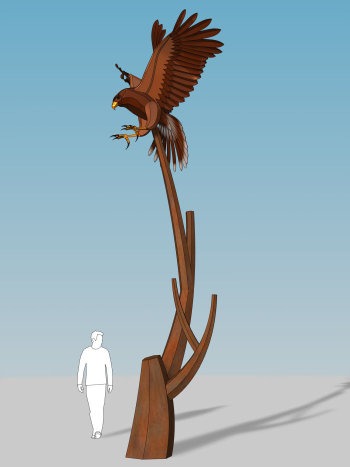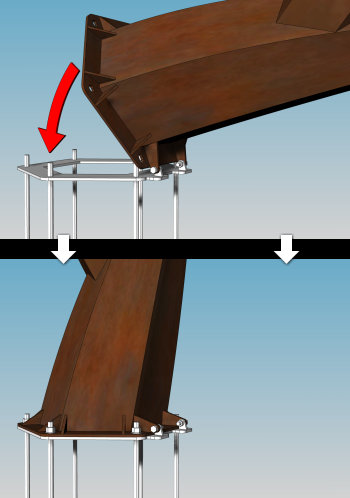I’m currently working out the engineering for a corten and stainless steel public art sculpture that will be sited at the entry of the Rio Bosque Wetlands Park in El Paso, TX. As always, I was taking some time to pay close attention to just how the sculpture would be installed at this early phase, rather than waiting until the day of the install and going, “oh no, how the heck is this going to work?” I find this process to save a lot of headaches down the line, and makes for a safe, quick install at the sculpture site, and that way myself and the client are both happy and content at the end of the day rather than exhausted and frustrated. For perspective, here is the basic design of the sculpture, which is over 20′ tall. The “tree” will be corten steel, and the hawk will be stainless steel with a proprietary ferric oxide patina:

As you may imagine, craning public art this large and top-heavy into place can be a daunting and tricky task. It often involves carefully guiding the sculpture into place while, at the same time, directing the crane operator very specific directions using only hand signals. You have to have at least one person standing right under the sculpture guiding this very heavy sculpture around. It’s dangerous work if not taken very seriously. Another tricky part of this sculpture is that there was no good way to lift the piece from the top, as the hawk’s wings would get in the way of any vertical lifting operation.
To make the installation of this public art safer, faster, and just plain easier, I took a cue from some flag pole designs, where the base is hinged on one side, and the pole is then tilted into place. Since the base of this sculpture will be buried in gravel, there was no harm in adding a little bit of hardware to it to make this happen. Now, we’ll just bolt the sculpture to a hinge on the stainless steel base plate as the sculpture is lying horizontally on the ground, then the entire sculpture can be tilted into place by the crane without any guidance from anyone on the ground… nobody has to stand under or even near the work as it’s lifted into place, as the sculpture just tilts right into the exact position automatically. Here’s a diagram of the base tilting into place:

(Note that the rods extending below the sculpture base are large threaded rods that will be embedded into a concrete footer that is not shown here for clarity.)